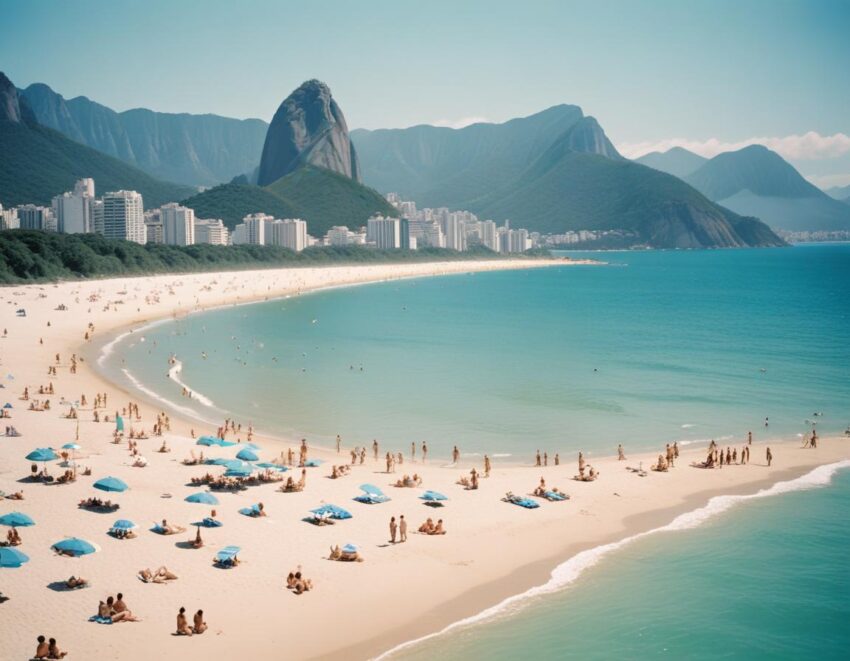Published on
August 22, 2025
By: Tuhin Sarkar

Brazil joins Mexico, Argentina, Dominican Republic, Colombia as iconic beach destinations for US tourists, and this full destination guide here for Americans shows why 2025 is the year to plan the trip. Across the Americas, sun-seeking travellers are looking for more than just sand and sea. They want affordable escapes, unique culture, and destinations that combine relaxation with adventure. That is why Brazil joins Mexico, Argentina, Dominican Republic, Colombia on the top list of iconic beach destinations for US tourists.
Each country offers something distinct. Brazil joins Mexico with long stretches of golden sand and world-famous city beaches like Copacabana. Brazil joins Argentina by blending coastal escapes with cultural depth, creating a journey that is both relaxing and enriching. Brazil joins the Dominican Republic by offering resort-style experiences but with a stronger flavour of history and nature. Brazil joins Colombia with vibrant rhythms and warm Caribbean waters, making every trip unforgettable. Together, these five countries form a powerful network of iconic beach destinations for US tourists, combining variety, affordability, and charm.
This full destination guide here for Americans is designed to show why Brazil joins Mexico, Argentina, Dominican Republic, Colombia at the centre of the travel conversation. US tourists are now choosing these beach escapes not only for sun but also for safety, value, and unforgettable experiences. The trend is clear: the Americas are setting the global standard for beach travel in 2025.
Why Beach Destinations Matter More Than Ever
Beach holidays remain the dream escape for millions of travellers worldwide. In 2025, as work-life balance changes and travel costs rise, tourists are seeking value, climate, and comfort more carefully. New global rankings show where the best beach experiences can be found. From Mexico’s vast coastline to Brazil’s cultural coasts and South Africa’s diverse shores, the data highlights how these countries deliver both quality and affordability.
For UK tourists, the appeal is clear. Beaches offer relaxation, activities, and sunshine in a single package. But destinations vary in cost, accessibility, and travel experience. Analysing beach counts, average prices, climate conditions, and overall travel ratings provides a strong picture of where to go. The results show that countries like Mexico, Brazil, and South Africa are leading the way in 2025, with India and the UAE also capturing strong demand.
Brazil Rises as a Sun and Culture Leader
Brazil takes second place with a travel rating of 94. The country features 38 beaches in the survey and averages $867 for travellers. Its warm climate, averaging 25.4 °C, makes it ideal for sun-seekers. Famous stretches like Copacabana and Ipanema combine beauty with culture, music, and nightlife.
UK travellers are increasingly drawn to Brazil because it delivers more than sand and sea. Cities like Rio de Janeiro and Salvador mix beaches with festivals, food, and heritage. Despite the long flight, Brazil remains competitive because of its lower costs compared to destinations like South Africa or Argentina. In 2025, it continues to rise as a key option for adventurous but budget-aware tourists.
South Africa Balances Diversity and Quality
South Africa comes third with a travel rating of 88. The country offers 47 beaches in the index, with an average cost of $1,177. While more expensive than Brazil or Mexico, South Africa compensates with variety. Its coastline stretches from the warm Indian Ocean in Durban to the colder Atlantic near Cape Town.
The average temperature of 18.2 °C is cooler, but the travel experience extends beyond sunbathing. Tourists combine beach holidays with safaris, wine routes, and cultural tours. For UK tourists, this creates a complete travel package. The slightly higher cost reflects the premium nature of South Africa’s experiences. Its high rating shows that travellers are willing to pay more for diversity and safety.
India Expands Its Global Tourism Appeal
India takes the fourth spot with a travel rating of 82. Although it has only 13 beaches listed, it offers some of the best value. With an average price of $447, India is the cheapest of the top countries. Its warm climate, averaging 24.9 °C, makes it reliable for sunshine holidays.
Goa, Kerala, and the Andaman Islands are the key attractions. These beaches combine palm-fringed sands with local culture and cuisine. UK tourists find India especially attractive because it offers low-cost luxury. Resorts and boutique hotels provide strong service at half the price of European or Caribbean options. In 2025, India is emerging as a serious competitor in the international beach holiday market.
UAE Combines Luxury with Accessibility
The United Arab Emirates (UAE) ranks fifth with a travel rating of 76. Featuring 41 beaches, the UAE offers a mix of city breaks and coastal escapes. With an average cost of $685, it is cheaper than South Africa but more expensive than India. Its climate is among the warmest, averaging 28.2 °C.
Destinations like Dubai and Abu Dhabi attract UK travellers with luxury resorts, modern facilities, and world-class shopping. The UAE’s success lies in its connectivity. Direct flights from London, Manchester, and other UK hubs make it easy to access. The combination of sun, safety, and luxury continues to draw tourists in 2025, though the high temperatures may not suit all.
Morocco and Colombia Show Promise
Morocco ranks next with a travel rating of 71. With 29 beaches and an average price of $469, it is an affordable option. Its cooler average temperature of 18.1 °C makes it pleasant in spring and autumn. Agadir and Essaouira remain favourites for UK tourists who want short-haul sunshine and cultural charm.
Colombia follows with a travel rating of 65. With just eight beaches listed, it is a smaller player but offers great value at $396. Its tropical climate averages 25 °C. Destinations like Cartagena and San Andrés are gaining recognition. For adventurous UK travellers, Colombia offers affordability and vibrant local culture.
Dominican Republic Maintains Caribbean Allure
The Dominican Republic ranks lower with a travel rating of 59, but it remains a strong Caribbean player. With 26 beaches and an average cost of $701, it is priced in the middle. Its warm climate averages 24.6 °C. Punta Cana and Puerto Plata remain famous for all-inclusive resorts that attract families.
Despite its lower rating, the Dominican Republic is still popular with UK travellers who want sun and sea in a resort setting. The competition comes from cheaper destinations like Mexico and Colombia, which offer similar experiences at lower prices.
Jordan and Argentina Face Challenges
Jordan receives a travel rating of 53. With only 10 beaches listed, its coastal offering is limited to the Red Sea near Aqaba. The average cost of $399 makes it affordable, and temperatures average 20 °C. While Jordan is better known for Petra and the Dead Sea, its coastal tourism is developing. It remains a niche choice for UK travellers seeking culture combined with seaside rest.
Argentina comes last in the ranking with a travel rating of 47. Despite having 10 beaches and a large coastline, it faces challenges. The average cost is high at $1,177, and temperatures average just 16.3 °C. This makes it less competitive compared to warmer and cheaper destinations. For UK travellers, Argentina’s distance and costs reduce its appeal, although it still offers unique cultural attractions.
Why Brazil’s Beaches Are Trending in 2025
Brazil is a country where coastline meets culture in dazzling ways. Stretching for more than 7,000 kilometres, its beaches range from wild Atlantic coves to soft tropical lagoons, surf-ready shores, and cosmopolitan city strands. In 2024, the country welcomed more than 6.7 million international visitors and recorded US$7.3 billion in travel spending, its highest figure in 15 years. In the first five months of 2025, international arrivals already reached nearly 4.8 million, up almost 50% year on year. For travellers, the message is clear: Brazil’s beaches are booming, and coastal escapes are defining the country’s tourism identity.
UK and European travellers are among those rediscovering Brazil’s shores. Sun and beach rank as the number one attraction for domestic tourists too, with 59% of Brazilians naming it their top travel priority. This national obsession is mirrored by global recognition, with names like Fernando de Noronha, Jericoacoara, and Porto de Galinhas consistently appearing in global “best beaches” lists. For anyone planning a trip, Brazil offers a mix of affordability, variety, and unique cultural flavour that few destinations can match.
The Northeast: Tropical Reefs and Natural Pools
If your idea of heaven is stepping into a crystal-clear natural pool, head to the Northeast. Pernambuco’s beaches, such as Porto de Galinhas, Praia dos Carneiros, and the extraordinary Fernando de Noronha archipelago, are among Brazil’s crown jewels. Noronha, a UNESCO World Heritage Site, limits visitor numbers, charges a preservation fee, and bans single-use plastics, ensuring its reefs, dolphins, and turtles remain pristine. Here you will find Baía do Sancho, a beach regularly voted among the world’s best.
In Alagoas, the Coral Coast presents an equally dazzling scene. Praia do Patacho and São Miguel dos Milagres offer low-key boutique pousadas set against long stretches of turquoise shallows. At low tide, Maragogi’s giant natural pools appear like secret aquariums in the ocean. For families and couples, these destinations combine affordability with a sense of luxury thanks to their intimate atmosphere.
Further up the coast, Ceará offers a wilder take on tropical beauty. Jericoacoara National Park is famous for its vast dunes, freshwater lagoons, and constant breezes that have made it a world-class kitesurfing hub. The rustic-chic village atmosphere adds a bohemian feel, making it perfect for younger travellers and adventure seekers.
The Southeast: Beaches with a City Beat
If you crave urban rhythm with your sea breeze, the Southeast is your playground. Rio de Janeiro remains one of the world’s most iconic coastal cities. Copacabana and Ipanema are not just beaches but global cultural stages. Here samba, football, and sunbathing collide in a dramatic setting of mountains and sea. These urban sands deliver more than views—they are a way of life.
São Paulo State brings its own stars, led by Praia do Tombo in Guarujá. This stretch has proudly held the Blue Flag certification for over 15 years, proof of its water quality, safety, and environmental management. It is also one of Brazil’s best surfing beaches, making it a favourite weekend escape for Paulistanos. The combination of world-class city access and high-quality coast makes the Southeast perfect for travellers who want to combine culture, gastronomy, and beach days in one trip.
The South: Surf, Blue Flags and Cooler Charm
Head south and the beaches take on a different character. Santa Catarina State is Brazil’s surf paradise, with names like Campeche and Praia Mole attracting riders from across the globe. The region also holds a strong share of Brazil’s Blue Flag beaches, part of a sustainability programme that now includes 49 certified sites across the country. Bombinhas, with its calm bays and family-friendly atmosphere, shows why this part of Brazil is ideal for those who want clean, well-managed coastal holidays.
The South offers cooler waters than the Northeast, but the combination of surf culture, sustainable practices, and vibrant coastal towns makes it appealing to a broad audience. For European travellers familiar with Mediterranean summer vibes, Santa Catarina offers a refreshing alternative in a new hemisphere.
Blue Flag Beaches: Sustainability as a Selling Point
Brazil is rapidly expanding its Blue Flag beach network. For the 2024–2025 season, the country counts 38 beaches and 11 marinas certified across six states, including São Paulo, Rio de Janeiro, Santa Catarina, Bahia, Alagoas, and Ceará. Another 60 sites are pre-approved for the coming year. For travellers, this label provides confidence: it guarantees clean water, lifeguards, accessible facilities, and environmental education.
For international visitors, Blue Flag status is a useful shortcut. It tells you which beaches are investing in quality and sustainability. For Brazil, it signals that the country is serious about protecting its natural treasures while welcoming more tourists.
Where to Stay: Hotels and Resorts by the Coast
Brazil’s hotel sector is riding the wave of renewed confidence. International chains are expanding aggressively, particularly along the coast. Accor, already the country’s largest operator, continues to add new properties, while Wyndham signed 10 new deals in 2024 alone. Marriott has entered the Brazilian midscale market with City Express by Marriott, planning as many as 30 hotels across the Northeast within the next 15 years.
Luxury also has a new face. In Rio, investors such as BTG Pactual are acquiring landmark properties, including Accor-managed hotels, reflecting confidence in Brazil’s coastal hospitality. Alongside these global names, smaller boutique pousadas flourish in destinations like Alagoas and Ceará, offering authentic and intimate stays. For travellers, the hotel landscape now provides everything from affordable family resorts to high-end retreats and rustic chic options.
What Travellers Can Expect to Pay
Brazil’s coastal tourism is diverse not just in setting but also in cost. Destinations like India may offer cheaper beach holidays globally, but Brazil balances price with quality. Average visitor spending per trip is around US$867, placing it between budget and luxury markets. In destinations like Alagoas or Pernambuco, boutique stays offer value-packed escapes. In Rio or São Paulo, costs rise but deliver city sophistication.
Travellers to Fernando de Noronha should budget extra, as the island requires both preservation taxes and park entry fees. Yet for many, the experience of swimming alongside dolphins in crystal-clear waters is priceless. Sustainability costs here are part of what keeps Noronha pristine and unique.
When to Visit Brazil’s Coast
Brazil’s Northeast offers year-round warm-water beaches, making it perfect for winter escapes from Europe. Rainfall peaks from April to July, but sunshine is still frequent. The Southeast and South are best in the austral spring and summer, from October to March, when temperatures rise and surf conditions improve. For UK travellers planning bank holiday or winter breaks, Brazil’s reverse seasons provide an escape to summer in the middle of northern winter.
Who Should Visit Brazil’s Beaches
Families will find safe, shallow pools in Porto de Galinhas or Maragogi. Couples looking for seclusion can head to Patacho or boutique stays in São Miguel dos Milagres. Adventure travellers will be drawn to Jericoacoara’s dunes and lagoons, while divers and snorkelers should not miss Fernando de Noronha. For city lovers, Rio remains a must, while Santa Catarina delivers surf and sustainability.
The diversity of Brazil’s coast means there is a beach for every type of traveller. The trick is matching your preferences—luxury, culture, family, or adventure—with the right region.
The Future of Coastal Tourism in Brazil
Brazil’s beaches are more than just a holiday spot. They are a central part of the nation’s tourism strategy. Record-breaking visitor arrivals and spending in 2024, followed by a strong 2025 start, show the appeal is only growing. Hotel investments, new Blue Flag certifications, and tighter sustainability policies point to a sector that is modernising while protecting its natural assets.
For travellers, this means more choice, better quality, and stronger guarantees that the Brazil they dream of will still be there for years to come. It also means that 2025 is an ideal year to plan that long-awaited trip.
Why Brazil Should Be Your Next Beach Escape
Brazil’s coastline is a world of contrasts and delights. From the emerald lagoons of Alagoas to the samba rhythms of Rio, from Blue Flag surf beaches in Santa Catarina to the untouched wilderness of Fernando de Noronha, every region offers something unique. With international arrivals and hotel development booming, it is also a destination easier to reach and stay in than ever before.
For UK and European travellers seeking both excitement and relaxation, Brazil’s coast answers every call. Affordable yet unforgettable, wild yet welcoming, it is a destination where the beach is never just sand and sea—it is a way of life. In 2025, Brazil is not only back on the world tourism map. It is leading it, one golden stretch at a time.
What the Beach Rankings Reveal for 2025
The rankings provide a clear message. Value, accessibility, and climate drive beach tourism in 2025. Mexico, Brazil, and South Africa lead because they offer strong mixes of quality and choice. India and the UAE are climbing fast, each for different reasons—one for affordability and the other for luxury.
For UK tourists, these insights matter. Bank holiday weekends and short breaks are now planned with both cost and climate in mind. Tourists want to spend less but still enjoy reliable sunshine and safe destinations. That is why countries like Morocco and Portugal’s Porto Santo also see rising demand.
The market is shifting. Traditional favourites like the Dominican Republic and Argentina now face stronger competition. Destinations that provide better value and accessibility are winning over British travellers.
A New Wave of Beach Travel Destinations
In 2025, global beach tourism is not just about sand and sea. It is about how countries manage price, climate, and accessibility together. Mexico leads the way with a perfect score, but Brazil and South Africa are close behind. India is showing that affordable luxury has global appeal, while the UAE proves that modern luxury continues to draw tourists.
For UK travellers, the results signal a new wave of choices. Beach escapes are no longer limited to the Mediterranean or Caribbean. The wider world now offers affordable, reliable, and exciting options. As travel patterns change, these rankings highlight the future of international tourism.
Source: Heepsy







